



RED PANDA
Classification:-
Kingdom: Animalia
Phylum: Chordata
Class: Mammalia
Order: Carnivora
Suborder: Caniformia
Infraorder: Arctoidea
Superfamily: Mustelidea
Family: Ailuridae
Genus: Allurus
The red panda (Ailurus fulgens, or shining-cat), is a small arboreal mammal native to the eastern Himalayas and southwestern Chian. It is the only species of the genus Ailurus. Slightly larger than a domestic cat, it has reddish-brown fur, a long, shaggy tail, and a waddling gait due to its shorter front legs. It feeds mainly on bamboo, but is omnivorous and may also eat eggs, birds, insects, and small mammals. It is a solitary animal, mainly active from dusk to dawn, and is largely sedentary during the day.
The red panda has been classified as Vulnerable by IUCN because its population is estimated at fewer than 10,000 mature individuals. Although red pandas are protected by national laws in their range countries, their numbers in the wild continue to decline mainly due to habitat loss and fragmentation, poaching, and inbreeding depression.
The red panda has been previously classified in the families Procyonidae (raccoons) and Ursidae (bears), but recent research has placed it in its own family Ailuridae, in superfamily Musteloidea along with Mustelidae and Procyonidae. Two subspecies are recognized.
Physical characteristics
Head and body of red pandas are 56 to 63 cm (22 to 25 in) long, and their tail about 37 to 47 cm (15 to 19 in). Males weigh 3.7 to 6.2 kg (8.2 to 14 lb) and females 4.2 to 6.0 kg (9.3 to 13 lb). They have long, soft reddish-brown fur on the upper parts, blackish fur on the lower parts, and a light face with tear markings and robust cranial-dental features. The light face has white badges similar to those of a raccoon, but each individual can have distinctive markings. Their roundish head has medium-sized upright ears, a black nose, and very dark eyes: almost pitch black. Their long bushy tail with six alternating yellowish red transverse ochre rings provides balance and excellent camouflage against its habitat of moss- and lichen-covered trees. The legs are black and short with thick fur on the soles of the paws. This fur serves as thermal insulation on snow-covered or ice surfaces and conceals scent glands which are also present on the anus.The red panda is specialized as a bamboo feeder with strong, curved and sharp semi-retractile claws standing inward for grasping of narrow tree branches, leaves and fruit. Like the giant panda, it has a “false thumb” that is an extension of the wrist bone. When descending a tree headfirst, the red panda rotates its ankle to control its descent, one of the few climbing species to do so.
Distribution and habitat
The red panda is endemic to the temperate forests of the Himalayas, and ranges from the foothills of western Nepeal to China in the east. Its easternmost limit is the Qinling Mountains of the Shaanxi province in China. It is found in southern Tibet, Sikkim, Assam and Bhutan in the northern mountains of Myanmar, and in southwestern China in the Hengduan Mountains of Sichuan and Gongshan Mountains in Yannan. It may also live in southwest Tibet and northern Arunachal Pradesh, but this has not been documented. Locations with the highest density of red pandas include an area in the Himalayas that has been proposed as having been a refuge for a variety of endemic species in the Pleistocene. The distribution range of the red panda should be considered disjunct, rather than continuous.A disjunct population inhabits the Meghalaya Plateau of northeastern India.
During a survey in the 1970s, signs of red pandas were found in Nepal's Dhoratan Hunting Reserve. Their presence was confirmed in spring 2007 when four red pandas were sighted at elevations ranging from 3,220 to 3,610 m (10,560 to 11,840 ft). The species' westernmost limit is in Rara National Park located farther west of the Dhorpatan Hunting Reserve. Their presence was confirmed in 2008.
The red panda lives between 2,200 and 4,800 meters (7,200 and 15,700 ft) altitude, inhabiting areas of moderate temperature between 10 and 25 °C / 50 and 77 °F with little annual change. It prefers mountainous mixed deciduous and conifer forests, especially with old trees and dense understories of bamboo.
The effective population size of the Sichuan population is larger and more stable than that of the Yunnan population, implying a southward expansion from Sichuan to Yunnan.
In August 2010, archaeologists uncovered red panda fossil remains in Washington county in the US state of Tennessee. Although none are known to exist in the wild in North America today, it is believed the red panda thrived in the mountains of eastern Tennessee approximately 4.5 million years ago.
The red panda has become exitrpated from the Chinese provinces of Guizhou, Gansu, Shaanxi and Qinghai.



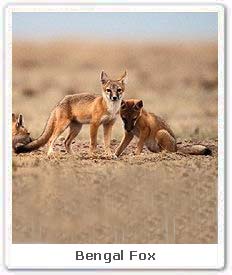 Physical appearance : Bengal Fox is a medium size fox. The colour of their coat is buff orange with paler underparts and black tip on its tail. It has reddish brown fur. Their head and body length is 45- 60 cm and weigh around 3- 4 kg. Tail length is 25 -30 cm. They have long sharp pointed canines and well developed molar teeth. Bengal Fox has relatively long ears. It has brown legs and black lips.
Physical appearance : Bengal Fox is a medium size fox. The colour of their coat is buff orange with paler underparts and black tip on its tail. It has reddish brown fur. Their head and body length is 45- 60 cm and weigh around 3- 4 kg. Tail length is 25 -30 cm. They have long sharp pointed canines and well developed molar teeth. Bengal Fox has relatively long ears. It has brown legs and black lips.



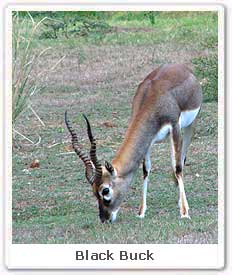 Physical appearance : Adult male Black Buck have black and white fur. Upper part of the body is black, while the under part and a ring around the eyes is white in colour. Even the fawns have these markings. The males are born lighter in colour, but turns darker at maturity. The females are usually hornless. Males have 24 inches long horns, which are twisted in tight spiral. They are about five feet long and weigh about 85 pounds. Males are dark brown in colour, while the young ones and females are light brown in colour. Black Bucks have the capacity to run 50 miles per hour. It is one of the fastest animal in the world.
Physical appearance : Adult male Black Buck have black and white fur. Upper part of the body is black, while the under part and a ring around the eyes is white in colour. Even the fawns have these markings. The males are born lighter in colour, but turns darker at maturity. The females are usually hornless. Males have 24 inches long horns, which are twisted in tight spiral. They are about five feet long and weigh about 85 pounds. Males are dark brown in colour, while the young ones and females are light brown in colour. Black Bucks have the capacity to run 50 miles per hour. It is one of the fastest animal in the world.


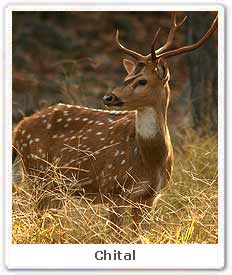 Physical appearance : Chital are 90 cm tall and weigh up to 85 kg. Its upper parts are reddish fawn and the under parts are white in colour. It has white spots all over the body. Antlers are present in males only that may exceed up to 75 cm. They shed them anually. Their antlers have six point plan. They are tuned back into the upward curve and have three points each. These antlers are used in mating displays and for the purpose of protection. They have white patch on the throat. They have a black dorsal stripe that run down their backs. They are good swimmers.
Physical appearance : Chital are 90 cm tall and weigh up to 85 kg. Its upper parts are reddish fawn and the under parts are white in colour. It has white spots all over the body. Antlers are present in males only that may exceed up to 75 cm. They shed them anually. Their antlers have six point plan. They are tuned back into the upward curve and have three points each. These antlers are used in mating displays and for the purpose of protection. They have white patch on the throat. They have a black dorsal stripe that run down their backs. They are good swimmers. 



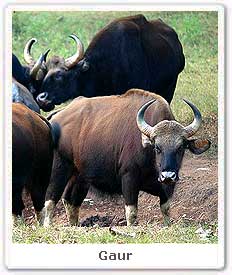 Physical appearance : Gaurs are 8.3 to 12 feet long. Males weigh around 1000- 1500 kg and the females weigh around 700 – 1000 kg. Males Gaurs are larger than the female Gaurs. Males are dark brown while the females are rust coloured. They have white colour legs. Length of their tail exceeds to 70- 100 cm.
Physical appearance : Gaurs are 8.3 to 12 feet long. Males weigh around 1000- 1500 kg and the females weigh around 700 – 1000 kg. Males Gaurs are larger than the female Gaurs. Males are dark brown while the females are rust coloured. They have white colour legs. Length of their tail exceeds to 70- 100 cm. 



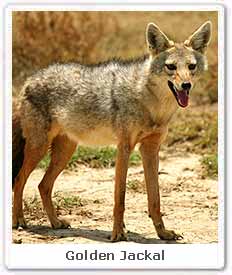 Physical appearance : Golden Jackal are 70- 85 cm long and weigh around 8 -10 kg. They are golden yellowish in colour with a reddish tail having a black tip. The tail itself measures upto 9 -14 inches. It has white mark on its throat and the back of the ears is darker in colour. Males are usually larger than the females.
Physical appearance : Golden Jackal are 70- 85 cm long and weigh around 8 -10 kg. They are golden yellowish in colour with a reddish tail having a black tip. The tail itself measures upto 9 -14 inches. It has white mark on its throat and the back of the ears is darker in colour. Males are usually larger than the females. 



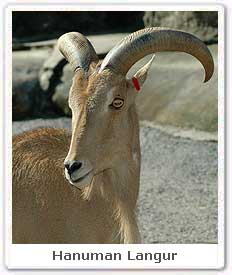 Physical appearance : Himalayan Tahr are 3- 4.5 feet long and weigh around 36-90 kg. They are 26 – 40 inches tall. They have small head and relatively short legs. They have large eyes and small as well as pointed ears. They have triangle shaped horns, curved abruptly backwards and than inwards. In winters Tahr has dense, reddish to dark brown woolly coat with a thick undercoat. In the spring they lose much of their coat, and it becomes lighter in color.
Physical appearance : Himalayan Tahr are 3- 4.5 feet long and weigh around 36-90 kg. They are 26 – 40 inches tall. They have small head and relatively short legs. They have large eyes and small as well as pointed ears. They have triangle shaped horns, curved abruptly backwards and than inwards. In winters Tahr has dense, reddish to dark brown woolly coat with a thick undercoat. In the spring they lose much of their coat, and it becomes lighter in color. 
